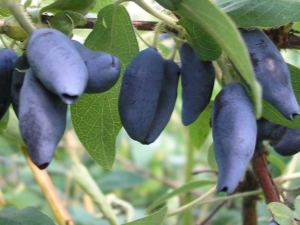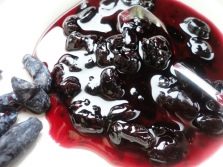Preparations of honeysuckle for the winter: ways to preserve the berries and recipes

Blue and purple honeysuckle berries have always been considered very beneficial to human health.In the summer, they are actively consumed directly from the bush, and in the winter, lovers can enjoy jams, compotes, jams and add frozen berries to pastries and dessert dishes.
Useful properties of berries
It should be mentioned that all parts of the honeysuckle exhibit healing properties. For one purpose or another, the berries themselves are used, as well as leaflets, flowers and even bark. The calorie content of honeysuckle is very low - only 40 kilocalories per 100 grams of berries, so the berries are selected for the preparation of therapeutic and dietary menus. The composition contains a large number of organic acids, for example, chlorogenic acid, which helps to resist viruses.
In addition, in the presence of polyphenols, they are also natural antioxidants. These substances can slow down the aging process and even act as a cancer prevention. Well-known vitamin C supports the immune system, and pectin elements remove harmful substances from the body and promote efficient digestion. In addition, honeysuckle is rich in sugars, B vitamins, potassium, phosphorus, sodium, magnesium and other useful elements.
A decoction of honeysuckle weakens the pain in arthritis and arthritis, in addition, strengthens the bones. Regular consumption of berries can lower cholesterol and clear blood vessels. Available in the potassium is responsible for the prevention of diseases of the heart system. Honeysuckle also has a good effect on eyesight, therefore it is even recommended as one of the components of the complex treatment of inflammatory eye processes.
Experts note that eating fruits will only benefit the respiratory organs, including the lungs. Pectins cope with constipation and help digestion, and the available fructose can reduce the amount of sugar in the blood. In addition, honeysuckle has diuretic properties, a beneficial effect on the skin and strengthens the immune system.
Contraindications
Despite its many advantages, this culture has contraindications. Of course, the use of honeysuckle is forbidden to people whose body simply does not tolerate it and reacts with various allergic reactions. Moderation of consumption is recommended for those suffering from diabetes. If you combine honeysuckle with drugs, you can dramatically lower blood sugar levels. Finally, one should be careful to be sick with increased acidity of the stomach, since there is a large amount of vitamin C in honeysuckle.
It is also worth mentioning that not all types of honeysuckle are edible to humans. Some of them contain prussic acid, which can provoke vomiting, nausea and gastric upset.
How to prepare?
There are various ways to preserve the berries for the winter. Previously, jam or jam was cooked more often from honeysuckle, and now freezing and drying is gaining popularity. Honeysuckle blanks can be created even without additional processing. For example, prepared jars can be filled with berries and sugar so that there is twice as much sugar. The jars are slightly shaken, sprinkled with a centimeter layer of sugar on top and tightly closed.
Honeysuckle can also be ground with sugar, taking both ingredients in equal quantities. Then the mass is slightly heated, rolled into jars and stored for storage in a room where the temperature does not exceed five degrees.
To freeze
Frost - the easiest and most popular way to preserve the fruit. The berries are thoroughly washed, sifted and dried. Then they are laid out on a pallet so that the layer reaches two centimeters. Honeysuckle is removed in the refrigerator for a couple of hours, then moved into the freezer. When the berries freeze, they need to be collected in plastic bags or plastic containers and left in the freezer.
You can also freeze the berries in the dessert format.A liter of fruit is poured into the prepared container and poured with a can of condensed milk, after which it is removed in the freezer.
Cook
Of course, honeysuckle can be transformed into jam. For cooking, ripe berries and sugar are taken in equal quantities. Berries are poured with sugar, and then they are deposited for the time it takes to put the juice. Within five minutes, the mass is heated, and then aged on low heat for seven to eight hours. Cooking continues until the berries cease to float to the surface. In the second stage, you can also add lemon juice or a little citric acid. Such jam will remain even without dense sealing.
To dry
Honeysuckle flowers can be dried for the winter to indulge yourself with a tasty drink during the cold season. They are laid out on a pallet, covered with several layers of gauze, after which they are cleaned for a week in a place where they will be provided with airing and low humidity. Honeysuckle will dry up until the plant parts begin to break with the slightest mechanical impact.
Dried flowers are harvested in a container that does not allow the ingress of sunlight and has a tight-fitting lid. Capacity itself is placed in a cool place. It is important to recall that the slightest hit of ultraviolet can destroy the beneficial essential oils contained in this culture. You can also dry the berries themselves. Immature fruits are selected, which are laid out on paper in a thin layer and then left for a week or a little more. They can also be placed on a baking sheet and placed in an oven, preheated to a temperature of 60 degrees. Honeysuckle to stay warm from six to ten hours.
Interesting recipes
Jelly lovers will love the idea of making this tender dessert of honeysuckle. It can be with or without gelatin. You need to prepare 800 grams of sugar and a liter of berry juice. Bring the solution to a boil, stirring continuously. When the syrup increases in volume by one third, it must be poured into containers and tightly closed. You can make jelly with gelatin. Berry juice is mixed with water in equal proportions, prepared gelatin is added to it (20 grams per liter are needed), everything is boiled for about five minutes. Upon completion, the product is bottled and sealed.
This berry is also prepared jam. Pre-worth a kilogram of honeysuckle, half a kilogram of sugar and about two glasses of ordinary water. Sand and berries are combined in a saucepan, poured with water and then mixed. Capacity is set on fire, and the substance is cooked until the berries are finally melted. The jam is laid out in prepared jars, which are tightly closed with a lid.
Without cooking it will be possible to cook and quick jam. In addition to a kilogram of liquid, one and a half kilograms of granulated sugar and one pack of citric acid are taken. Berries are picked, washed and dried. They are covered with sand, and then ground with a blender. It is necessary to process the mixture until the crystals disappear and the consistency becomes homogeneous. At the end of cooking citric acid is added to the jam.
Prepares very quickly and honeysuckle confiture. Prepared berries are pounded to a state of mashed potatoes and mixed with sugar in equal quantities, after which they are laid for four hours. The finished mass is to be put on fire, wait until it boils, and pour it into containers.
It's great to use what remains after squeezing the honeysuckle juice, for cooking marshmallows The berry mass is mixed with sugar in equal quantities, after which it is deposited for about five hours. Then the substance is rolled out, sprinkled with sugar and dried. The cooled marshmallow must be cut into slices of the required size. Returning to the juice, we note that it is prepared in a two-stage system.First, the berries to be blanched, and then squeezed with special equipment.
If necessary, you can sweeten the resulting drink. In the case when the juice is to be stored for a long time, it will need to be baked for five minutes, immediately bottled and closed.
Puree of honeysuckle is prepared as follows. The berries are washed, sifted and peeled from the stalk. Then the fruits are filled with a small volume of water, and then placed on the fire. The liquid must be heated, not boiling, and sugar is added to the finished substance, with about 500 grams of sand per kilogram of berries. The mixture is periodically stirred and heated to a temperature of about 85 degrees, at which time it will have to stay for about five minutes. The resulting puree is decomposed into containers and clogged.
Tips
When collecting honeysuckle, it is important to adhere to several important rules. Selected fruits should be blue or purple, but in no case red or yellow. The shape of the berries is elongated, there is a whitish coating. It is also necessary to immediately remove those samples that are damaged or damaged by something.
If flowers are necessary, then you need to make sure that they belong to edible species. They must also be completely formed or else be a closed kidney. Honeysuckle bark is desirable to collect in the first spring months.
Storing fresh honeysuckle in the refrigerator can be from two to three days. In the freezer, the berries will save up to six months. If the juice is squeezed from the honeysuckle, it will need to be consumed throughout the day. Jam is most often rolled up, but it is also allowed to use capron lids, which provide a tight seal.
Learn more about how to prepare honeysuckle for the winter, you will learn from the following video.

































